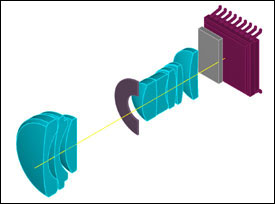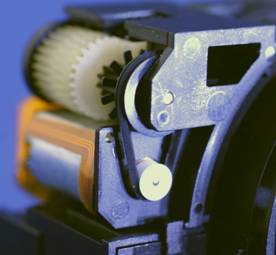Recent Press releases
Secrets behind the Caplio's new wide-angle zoom lens
Ricoh combined a unique lens arrangement, a high-refractive index, and a low-dispersion aspherical lens to develop an entirely new wide-angle zoom lens for compact digital cameras.

Until now,the creation of compact, wide-angle zoom lenses for digital still cameras has been an area of some difficulty. This was largely due to the fact that such cameras require a greater amount of peripheral light than conventional 35mm cameras to avoid shading of the CCD and compromised images resulting from limited dynamic ranges. Indeed, many users of digital cameras have felt somewhat restricted by the maximum wide-angle setting equivalent to 35mm, when conventional 35mm cameras commonly offer wide-angle settings of 28mm.
Driven by a strong sense of commitment to its customers, Ricoh has tackled this issue to produce a 3X zoom lens capable of offering performance equivalent to a 28mm lens in 35mm format - the lens of the Caplio G4wide.
This lens consists of eight lenses in three groups. The first group is the most important in the achievement of such wide-angle capability and features a meniscus aspherical lens made from highly refractive, low-dispersion glass. The second group of lenses also has an aspherical lens, the placement of which optimizes the overall lens arrangement, thereby providing superb aberration compensation despite significant increases in off-axis aperture efficiency. As a result, the lens offers excellent MTF performance, ensuring a peripheral light ratio of 80% (up from 66% in previous models).
Smaller cameras also tend to offer smaller apertures. Ricoh, however, has created the new lens system to offer a maximum aperture setting of f/2.8 for wide-angle shooting and f/4.3 for telephoto shooting. As a result, light diffraction is reduced, faster shutter speeds can be selected, and high-quality images can be recorded at all times.
Secrets behind the Caplio's 0.14-second shutter release lag
A combination of mechanical and electronic cams enables rapid, precision zooming and autofocus
Embracing both mechanical and electronic cams in an ingenious and complex manner, the Caplio G4 achieves a shutter release time lag of just 0.14 seconds - shorter than any other camera of its kind. During zooming, the Caplio G4wide first uses the mechanical cam to achieve an approximate focus, then switches to the electronic cam to adjust for precision. In this manner, shutter release lag is minimized by placing the lenses in the correct position in the absolute fastest time.
The Caplio G4wide also has another unique feature in the form of a Ricoh original belt-drive zoom system, which achieves reduced noise during zoom operation.

Secrets behind the Caplio's high-level image quality
High-quality image processing
With a 1/2.7-inch RGB CCD offering the power of 3.24 effective megapixels, the Caplio G4 Wide blends the benefits of superb color reproduction, high speed, and low power consumption - all within compact dimensions.
Image quality is also refined through fine-tuned Ricoh proprietary image processing technologies.
The reproduction of high-luminance areas (of the subject) is further enhanced by gamma optimization.
| White balance and color temperature settings have been unified with the CCD to achieve more natural color reproduction |
An improved analog signal processing unit reduces the signal-to-noise ratio by 30% (compared to previous models), minimizing interference in images.
Glossary
ShadingShading is the manifestation of uneven sensitivity on the part of the CCD. It causes gradations or differences in brightness in digital images which do not exist on the actual subject.
Dynamic rangeDynamic range is a measurement of a device's ability to reproduce signals. It is expressed numerically using the unit dB, and can be expressed in bits in the case of digital devices. It is calculated as the ratio of the minimum to maximum signals of a device, or alternatively by subtracting the noise level from the maximum signal level. The dynamic range of a device shows its ability to reproduce fine signals. In other words, it indicates the level of signal resolution actually available to the device.
Aperture efficiencyAperture efficiency is the ratio between the light flux formed on the image point along the optical axis and that formed outside the optical axis in photo lenses and related equipment.
Meniscus lensAlso known as a cemented lens, a meniscus lens has both a convex side and a concave side.


